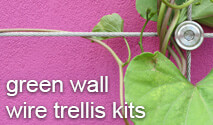Planting advice for Wire Trellis and Green Facades
Planting advice for Green Walls
Climbing plants have developed a variety of different climbing mechanisms by which they attach themselves to the support provided.
Broadly speaking, there are the climbers that are self-clinging or ones that need support. There are 3 main types of support that can be provided for these species; a trellis or framework made up of horizontal and vertical elements, just vertical supports or just horizontal supports. This will depend on the type of species chosen and the limitation of the design.
There are 4 main categories of climbing plants;
1. SELF-CLINGING CLIMBERS
This includes climbers that use lateral shoots with glandular discs that adhere to any surface, and adventitious root species that can grow over large distances without any means of auxillary support. Boston Ivy (Parthenocissus tricuspidata) and climbing Hydrangeas (Hydrangea petiolaris) are examples.

However, occasionally these types of climber can cause damage to the building, and this kind of greening is best avoided if possible. It is much better to provide a green wall façade system that climbers can use as a scaffold to climb up - this means that the building gets all the benefits from being greened, but avoids any potential structural damage.
2. VINES - CLIMBING PLANTS
Vines have a very strong natural tendency to grow vertically. They twine around their supports by the circular movements of their stem tips. There are many different types of vines that can be used on a green façade using vertical supports, some examples are listed below;
- Wisteria (Wisteria Sinensis)
- Honeysuckles (Lonicera)
- Hops (Humulus Lupulus)
- Morning glory (Ipomoea Hederacea)

In theory, vines only need vertical supports, however in the case of wisteria for example, with a little effort, vines can be trained along horizontal supports. The spacing needed between the vertical supports depends on the species.
For slow to moderate growing climbers the gap between the supports to ensure maximum coverage needs to be approximately 200-400mm. For very vigorous species the supports can be as much as 800mm apart.
3. LEAF-TWINING CLIMBERS and TENDRIL CLIMBERS
Leaf- twining climbers depend on their leaf stems to hold on. These tend to be mainly deciduous. During the winter the dead leaf stems continue to hold onto the support even though the stems are more brittle. Much of the weight is taken by the plants stems being intertwined around the supports.
The most popular leaf-twining climbers are Clematis and Nasturtiums (Tropaeolum).
Examples of these climbers are;
- Passion flowers (Passiflora)
- Grape vines (Vitis)
- Ampelopsis (Ampelopsis Brevipedunculata)

A combination of horizontal and vertical elements offer the best kind of support for both of these types of climbers.
The size of the lattice depends on the vigor of the plants chosen. Slow to moderate climbers for example clematis, would need a smaller grid size than a vigorous climbing species such as grape vine.
- Slow to moderate climbers (e.g. Clematis) - Grid size approx. 150x200mm
- Vigorous climbers (e.g. Grape vine) - Grid size approx 300x500mm
4. RAMBLERS AND SCRAMBLING PLANTS
These types of plants use thorns, bristles and prickles in order to climb their way up a support. Their means of growing does not make them ideal candidates for upward growth, instead they lend themselves perfectly to be trained in a largely horizontal manner. This makes them ideal for large stretches of horizontal growth with a small vertical range.
The ideal support is composed purely of horizontal supports, the optimum vertical distance between the supports is approx. 400mm.

Other Considerations
Our green wall systems can be designed to incorporate a variety of climbers with different climbing mechanisms. We can also help to design a façade to fit almost any space, using a combination of horizontal, vertical and trellis façade.
The design of your green façade can also incorporate edible plants, for example tomatoes, runner beans, cucumbers, melons, courgettes, peas and passion-fruit can all be successfully grown amongst more permanent plants. This provides you with year long interest and also the potential of a tasty harvest!

Our vertical garden systems can also be adapted to be used as a method of creating an espalier or pleaching.
Page content by Nick Arrowsmith Google+



